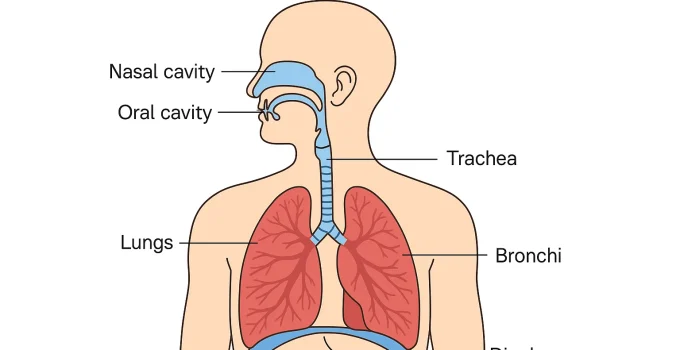How Do We Breathe?
Breathing is something you do every moment without thinking. But have you ever wondered how air gets in and out of your body? The process of breathing is more than just taking in air—it’s a complex system of organs and muscles working together to give your cells the oxygen they need to live.
Let’s break down the amazing process behind every single breath you take!
🔍Dive Deeper
- Why Do We Need to Breathe?
- Step 1: Inhaling Air
- Step 2: Gas Exchange in the Lungs
- Step 3: Exhaling Carbon Dioxide
- What Controls Our Breathing?
- 🎯 Final Thoughts
- 📚 References
🌬️ Why Do We Need to Breathe?
Every cell in your body needs oxygen to make energy. This process is called cellular respiration. When cells use oxygen, they create a waste gas called carbon dioxide. So, breathing is really about two things:
- Getting oxygen in
- Getting carbon dioxide out
Your respiratory system works non-stop to make this happen.
📊 Did you know? The average person uses 550 liters of oxygen per day! [1]
༄ Step 1: Inhaling Air
Breathing starts with a process called inhalation. Here’s how it works:
- Your diaphragm (a dome-shaped muscle under your lungs) contracts and moves downward.
- Your rib muscles pull your ribcage upward and outward.
- This creates more space in your chest and lowers the pressure inside your lungs.
- Air rushes in through your nose or mouth, down the trachea, into the bronchi, and finally reaches the alveoli in your lungs.
| Body Part | What It Does During Inhalation |
|---|---|
| Diaphragm | Contracts and moves down |
| Rib muscles | Pull ribs up and out |
| Chest cavity | Expands to let air in |
🌬️ Interesting fact: You take about 20,000 breaths every day—more if you’re active! [2]
🫁Step 2: Gas Exchange in the Lungs
Once air reaches the alveoli (tiny air sacs in your lungs), something amazing happens—gas exchange:
- Oxygen moves from the alveoli into tiny blood vessels called capillaries.
- At the same time, carbon dioxide in the blood moves into the alveoli to be exhaled.
This all happens through diffusion, where gases move from an area of higher concentration to lower concentration.
📊 Surprising stat: The lungs contain around 600 million alveoli, giving you a gas exchange surface area the size of a tennis court! [3]
♨️Step 3: Exhaling Carbon Dioxide
Now it’s time for exhalation, or breathing out:
- Your diaphragm relaxes and moves upward.
- Your rib muscles let your chest fall inward.
- The space in your chest gets smaller, pushing air out of the lungs and through your mouth or nose.
This air carries carbon dioxide out of the body, completing the cycle.
📊 Quick fact: The air you exhale contains about 100 times more carbon dioxide than the air you breathe in. [4]
🧠What Controls Our Breathing?
You don’t have to think about breathing—your brain handles it for you automatically. The brainstem, especially a part called the medulla oblongata, checks the levels of carbon dioxide in your blood and tells your body when to breathe.
Your breathing can also change based on:
- Exercise
- Emotion (like fear or excitement)
- Talking, singing, or yawning
| Trigger | Breathing Response |
|---|---|
| High CO₂ levels | Faster breathing to remove it |
| Exercise | Deeper, more frequent breaths |
| Holding your breath | Brain eventually forces you to exhale |
📊 Did you know? You can hold your breath voluntarily, but your brain will eventually override you and force a breath to protect your body. [5]
🎯 Final Thoughts
How do we breathe? Breathing may seem simple, but it’s a highly organized process that keeps you alive every second. From the muscles that move your chest to the millions of alveoli in your lungs, your respiratory system is constantly working to get oxygen in and carbon dioxide out. So the next time you take a deep breath, remember: your body is doing something incredible.
📚 References
- National Geographic. “The Human Body: Breathing and Respiration.” https://www.nationalgeographic.com/science/article/breathing-and-respiration
- American Lung Association. “How the Lungs Work.” https://www.lung.org/lung-health-diseases/how-lungs-work
- Cleveland Clinic. “Alveoli Function and Structure.” https://my.clevelandclinic.org/health/body/22901-alveoli
- Khan Academy. “Gas Exchange in the Lungs.” https://www.khanacademy.org/science/biology/human-biology/respiratory-system/a/gas-exchange
- Smithsonian Science Education Center. “Why Can’t You Hold Your Breath Forever?” https://ssec.si.edu/stemvisions-blog/holding-breath
📌Learn More About the Respiratory System
- What Are the Main Organs of the Respiratory System?
- How Do We Breathe?
- How Does the Diaphragm Work?
- How Do the Lungs Work?
- Why Do We Cough?
- Why Do We Hiccup?
